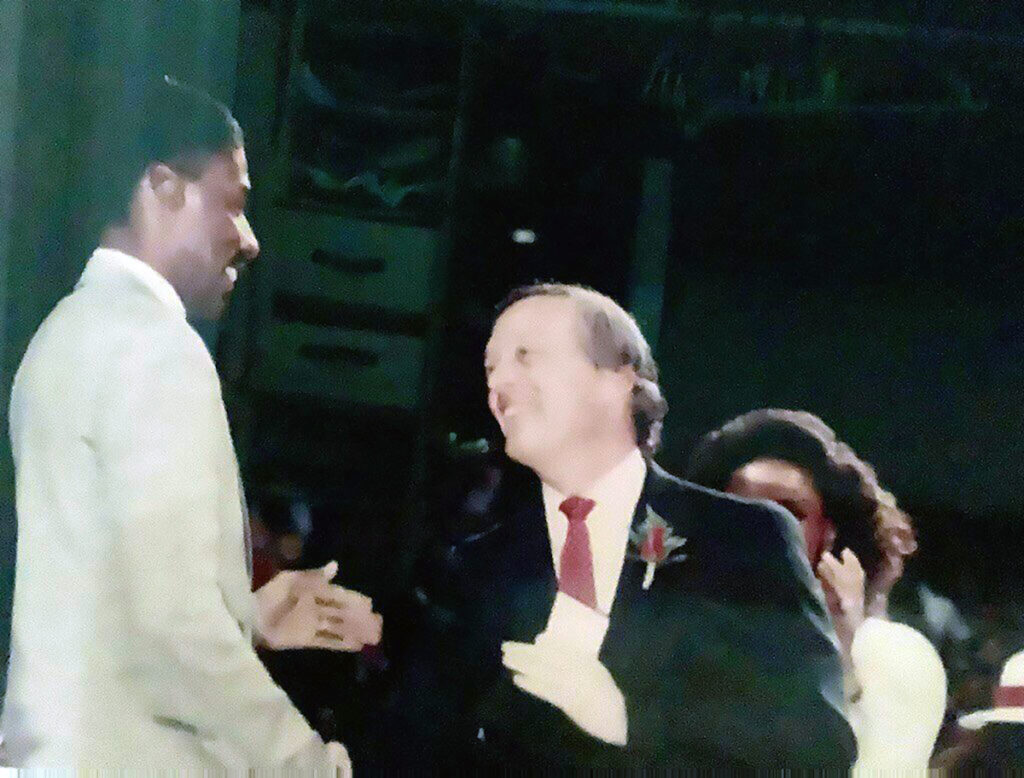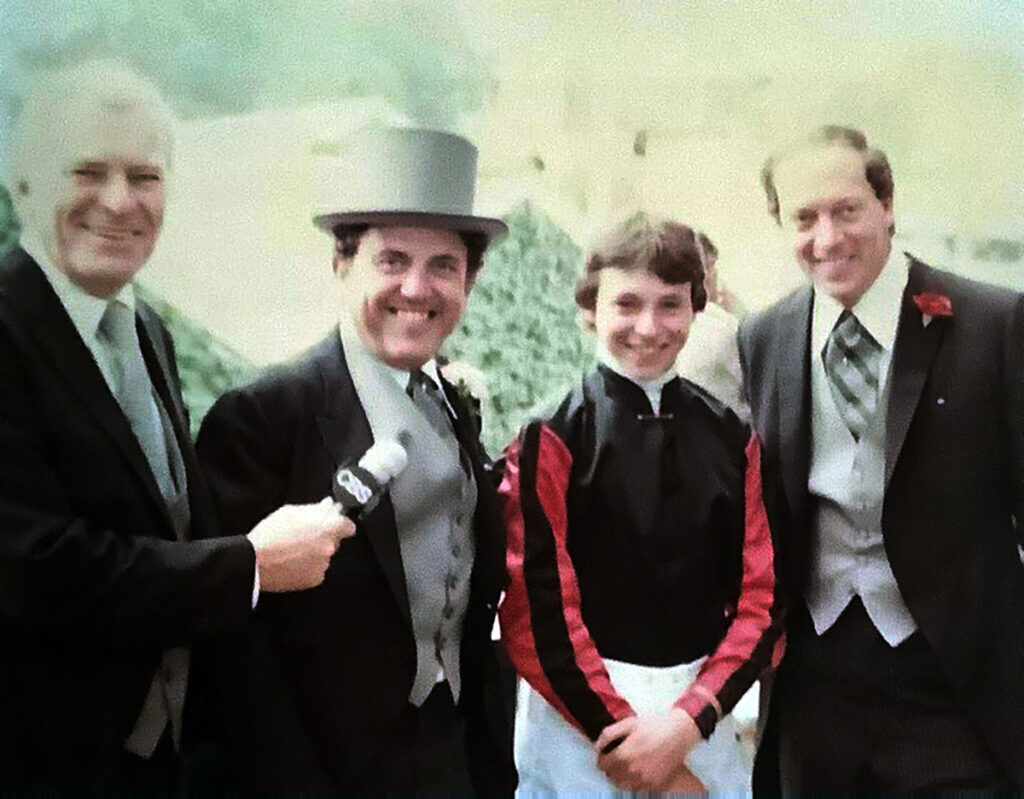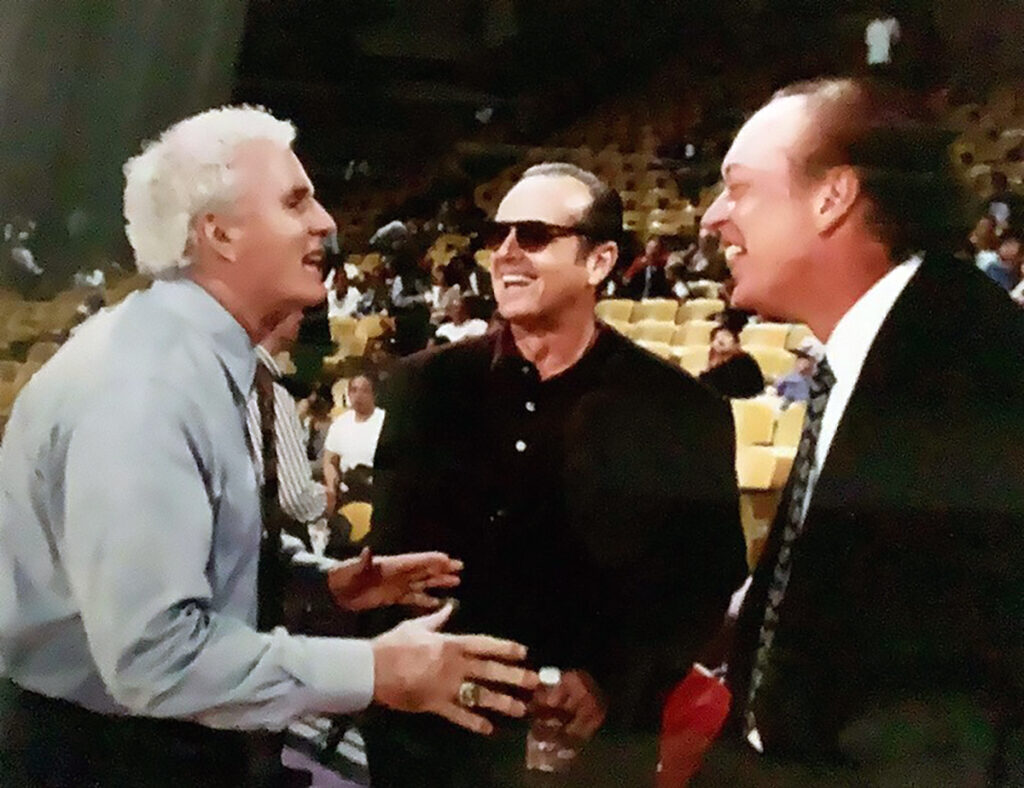Every Photo on My Office Wall has a Story
Pictures on a wall.
Throughout my career I’ve collected photographs from my various assignments and experiences, and they adorn the walls of my office.
Whenever I look around I recall the stories behind the pictures.
Virtually all of them carry a story beyond the event I covered and the people involved.
So, I’ve decided to not only share the photos from time to time, but what they represent as well.
Here goes.
Julius Erving and myself
With the NBA playoffs getting underway, and the Philadelphia 76ers earning the number one seed in the Eastern
Conference for the first time in 20 years, perhaps the Sixers all-time great came to mind.
Julius Erving, known better as Dr. J, was the first truly acrobatic superstar in NBA history.
He began his career in the American Basketball Association, and his presence in that rival league ultimately forced a merger between the two leagues after the 1975-76 season. The NBA was considerably more established, but despite possessing the talents of so many superior players, they didn’t have Dr. J, who created the presence of the modern pro basketball star.
Erving never missed the post-season in his 16-year career, winning one NBA championship in 1983.
He was known for his breathtaking slam-dunks from the free-throw line including reverse dunks from under the basket.
He was a true artist on the court, and his balletic style was unmatched.
The photo was taken at his retirement ceremony at the Spectrum, where the Sixers played their home games.
Doc asked me to serve as his Master of Ceremonies, and his farewell was a testimonial by teammates and other NBA stars of his greatness.
Amazingly enough, most of the NBA players, going back as far as 10 years ago, were not aware of Julius Erving.
You’d be surprised how many, if not most players have no idea about the history of the game they play.
Another factor was the timing of Dr. J’s career.
Shortly after his emergence on the scene, Larry Bird and Magic Johnson superseded Erving as the top stars.
The Celtics-Lakers rivalry in the 80’s were about Bird and Magic. Then came Michael Jordan.
Julius Erving, was unquestionably, one of the game’s all-time greats.
If you ever saw him play, you know what I’m talking about.
But I also believe he was overshadowed by the superstars who followed shortly after.
Jack Whitaker, Eddie Einhorn, Steve Cauthen, and myself
With the Preakness Stakes history, and one leg of horse racing’s Triple Crown remaining (The Belmont Stakes), I recalled the one horse race we covered during our time as host of the CBS Sports Spectacular.
The Kentucky Derby held the first Saturday of May is always the crown jewel of the sport’s major events, but I don’t think I would trade any of those three for a trip to Royal Ascot in Great Britain where the Gold Cup is the premier race of the season.
Ascot Racecourse is located in Ascot, Berkshire, England, 29 miles from London, and it’s the scene of 26 races in its June campaign.
The week of Royal Ascot is a five-day affair, and from the arrival of the Royal Procession at 2:00 PM each day, followed by the communal singing around Ascot’s bandstand is incomparable.
The Kentucky Derby is known for the spectacular variety and color of women’s hats, but Ascot is about the modest, but fashionable ladies’ dresses as well.
Gentlemen are reminded that they are required to wear either black, grey or navy “morning dress” ( formal wear), including a black or grey top hat.
In 1978, the CBS Sports Spectacular, our network’s version of ABC’s Wide World of Sports, journeyed “across the pond”, to cover the Gold Cup and the surrounding spectacle.
Looking at the photo above, joining me to the left is the late Jack Whitaker, a brilliant journalist and wordsmith who specialized in golf and horse racing at CBS. No sportscaster has ever had more class or has been more eloquent than Whitaker, who passed away in 2019 at the age of 95.
Next to him is Eddie Einhorn, who was the Executive Producer of the CBS Sports Spectacular, and later, was minority owner and vice chairman of the Chicago White Sox. It was Einhorn, who put televised college basketball on the map, founding TVS Television Network which was the first to air games to regional networks.
The jockey in the picture, is Steve Cauthen, who was the youngest to win the U.S. Triple Crown, and the first jockey to win over $ 6 million a year.
Yes, Royal Ascot is special.
Hubie Brown, Jack Nicholson and myself
I first met Jack Nicholson sitting next to him on a flight from Philadelphia to Los Angeles during the 1982 NBA Finals.
Before the age of charter flights, now the mode of travel for all sports teams, commercial flights was the only way to go.
Thus, ordinary travelers like we are, would sit in the midst of the likes of Kareem Abdul-Jabbar, Magic Johnson,and James Worthy.
It may be hard to believe, but it’s a fact.
So there I was, sitting next to one of the foremost film actors in history, chatting about hoops.
Nicholson loved pro basketball. You may have seen him on TV sitting courtside at Laker games at the Forum or more recently, the Staples Center.
When we telecast Laker games in L.A., my partner and I would pay homage to Jack, and, naturally, talk basketball.
On this occasion, my broadcast partner for many years, first on CBS, then with TNT, Hubie Brown had some laughs prior to the start of the game.
Nicholson was not at those games for show. He was a true Laker fan, and one of the most knowledgeable NBA people I’ve ever met.
His favorite Laker back in those days, was Norm Nixon, the team’s point guard.
Nixon, was a two-time All-Star and won two NBA championships with the Lakers before he was traded in 1983, to the then San Diego Clippers for Byron Scott. Scott became Magic Johnson’s backcourt partner and was a major part of three Laker titles.
Myself and Jack Nicholson
I was walking along one of the streets on the Left Bank in Paris on a blistering hot day in July of 2003, when I noticed Jack Nicholson getting out of a car and walking to a bistro right near to where I was.
We noticed each other and he had something he wanted to say.
There was a woman in the car who was impatiently imploring the actor to return to the car.
The woman was actress Diane Keaton, who was filming Something’s Gotta Give, with Nicholson.
But Jack wanted to talk and waved Keaton and the driver to leave.
There, he told me he had been thrown out of a game, the previous season, because he was harassing a referee who had made a call against the Lakers.
It said he was shocked, and showed me a letter he wrote to then-Commissioner David Stern protesting the ejection.
Nicholson said he was a long-time season ticket holder, which he was, and Stern was aware, and that the ref’s call was horrible.
He told me the Commissioner proceeded to apologize for Nicholson’s ouster, but defended the call by the referee.
The actor was satisfied, if not smug about the incident, and the letter he received from Stern.
The following season, we talked about Something’s Gotta Give.
At the end of the film, Jack’s character and Keaton’s realize they are finally meant for each other and indulge in a kiss and an embrace on one of the bridges over the Seine River.
It is the cold of winter, the actors are bundled up in heavy coats and scarves. Snow begins to fall.
But the scene was filmed in the scorching heat of summer.
And Jack Nicholson, who had seen it all on the basketball court, and done it all in the movies, revealed he was soaking wet with sweat from the heat, making it the most uncomfortable he had ever been in a film.
The illusion of the movies.
Every photo on my office wall has a story.
These were a few of them.




